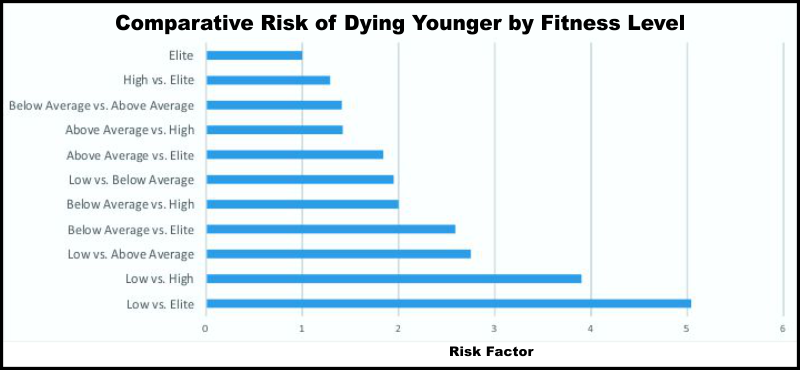
Is Exercise Really Better for Your Health than Not Smoking?
It’s been all over social media in the past couple weeks. The results of a study on the relationship between exercise, health, and longevity which tracked over 122,000 participants since 1991 have been released, and many people are shocked by the results. It turns out that not exercising is worse for your health than smoking!

Many news media outlets have reported on this with headlines like “Not exercising might pose bigger health risk than smoking”. While the study did indeed conclude this, if we only focus on this one sensational finding, we miss the real point. Your friendly neighborhood Dynamo fitness expert has taken the time to review the actual Journal of the American Medical Association article so you don’t have to. I’ve translated the findings into plain English (well, as plain as something this technical can get). Here is what we really need to get from this study…
It turns out that smoking is less likely to kill you young than not exercising!
Why Did They Do the Study?
The researchers were testing the conclusions of previous studies that showed that beyond a certain level of fitness, exercise could actually become harmful. What they found is that these studies were, quite simply, wrong. It turns out that all of these previous studies depended upon self-reporting for measuring the fitness of the participants. Not to put too fine a point on things, the participants were lying. This led to some incorrect conclusions.
How Did This Study Differ?
The researchers, medical doctors Kyle Mandsager, Serge Harb and Paul Cremer, used cardiovascular fitness as measured on a treadmill as the base for determining the fitness level of the subjects. The fitness levels were therefore entirely objective.
The measure of fitness was determined by METS. So what the heck are METS? You may have seen this measure on exercise machines and wondered what it meant. You’re not alone. Most people have no idea. METS = Metabolic Equivalent, and it’s a measure of how much oxygen the subject is burning during activity compared to being at rest. Sitting on your couch flipping channels, you’re at 1.0 METS. On the treadmill, you might see 8 METS or some other number. In the case of our example, this would mean you’re burning 8 X as much oxygen as you are at rest.

In the study, fitness level was determined by how many METS above resting the subject could achieve, so Elite athletes were at or above the 97.7th percentile for METS. Unlike exercise machines which estimate METS based upon a formula, subjects in this test were hooked up to a breath monitor and actual oxygen consumption was measured, so in this case METS are a very accurate standard to go by.
The doctors followed subject deaths until the end of 2017 and have now published their results.
Test subjects were put on a treadmill and hooked up to the same kind of monitoring machines shown here. This provided an objective measure of their relative fitness levels.
The Test Subjects
The test subjects had a mean average age of 53.4 years at the point of entering the study. The good doctors tracked these people for 22 years, from the beginning of the trial until the end of December 2014. Subjects were 60% male and 40% female. These age and gender groups were further divided in to categories based upon their cardiovascular fitness. The five resulting groups were:
Low: Below the 25th percentile (people who probably never exercise)
Below Average: 25th to 49th percentile (seldom exercise)
Above Average: 50th to 74th percentile (exercise at least occasionally)
High: 75th to 97.6th percentile (regular exercise)
Elite: 97.7th percentile and above (those who exercise intensely and religiously)
During the course of the study, 13,637 participants died of various causes. This represents just over 11% of the study population. The doctors also adjusted for deaths that resulted from non-age related factors, such as accidents or cancers that were not in any way related to lifestyle (Hey, any of us can get unlucky).
So What Did the Study Conclude?
A direct quote from the JAMA (Journal of the American Medical Association) article:
“Conclusions and Relevance: Cardiorespiratory fitness is inversely associated with long-term mortality with no observed upper limit of benefit. Extremely high aerobic fitness was associated with the greatest survival and was associated with benefit in older patients and those with hypertension. Cardiorespiratory fitness is a modifiable indicator of long-term mortality, and health care professionals should encourage patients to achieve and maintain high levels of fitness.”
What the Heck Does that Mean?

In plain English, it means that as your cardiovascular fitness increases, so does your overall health and longevity, with no upper limit! The fitter you are, the longer you will live on average, and the fewer health problems you will have. Period.
Your gender, age, ethnicity, and comorbidities* make no difference. High fitness levels for all these groups equals a likelihood of a longer, healthier life and the fitter you are, the greater the benefits.
Quite simply, the fitter you are, the longer you are likely to live – and the healthier will be, even if you have other conditions like diabetes or high blood pressure.
*other factors, such as a history of diabetes, hypertension, heart disease, renal disease, and smoking
The Resulting Morbidity Numbers by Hazard Ratio
The following chart, kindly prepared by yours truly, graphically demonstrates the study results. It shows the Hazard Ratios by contributing factor (i.e. diabetes, smoking, and heart disease). Now that of course is medicalese, so what does Hazard Ratio mean?

The actual data from the longevity and exercise study. The likelihood of dying during the study is directly linked to fitness level, with Elite fitness levels having the lowest Risk Factor, but notice the 3rd bar, which shows that even moderate exercise substantially reduces your risk.
It’s essential to realize that many of the people in the study had comorbidities. These are conditions such as hypertension (high blood pressure), heart disease, hardening of the arteries, or they were smokers. Hazard Ratio (or HR) is the measure of how much influence their fitness level had on longevity, despite the presence of these other conditions.
Very simply, the doctors measured the fitness level of these patients over a 22 year period and recorded how many people from each fitness grouping died within the period of the study. By this method, they were able to quantify how much more likely you would be to die young and suffer from poor health if you never exercised, than if you exercised regularly or were an elite athlete.
No Such Thing as Too Fit
The simple conclusion: The fitter you are, the longer you are likely to live, and the healthier you will be. Most of us knew that, but this is science, folks. Thanks to this study, we now know that there’s no such thing as being too fit.
For those who might want to read it, the actual study is here.
Will Dove
Latest posts by Will Dove (see all)
- Body Weight Training 2.0: Calisthenics - 22 Apr
- All About Protein Powders - 9 Apr
- Top 5 Fitness Trends for 2019 That You Should Try - 30 Mar
